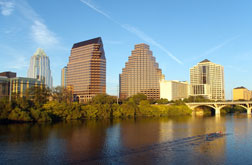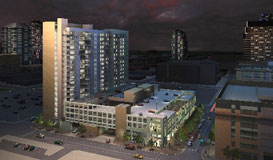 © Joseph Allen - FOTOLIA Austin's unique profile is changing.
|
Austin, Texas—As many as 18 announced highrise projects representing $1.5 billion worth of work may break ground in the next year or so in the downtown section of this unique city. The plans reflect a sharp upsurge in downtown tower construction, a market that had been dormant in the Texas capital since the mid-1980s and then flickered to life again in 2004 with a 31-story Hilton hotel.
Now the flickerings are closer to an explosion. As many as 18 projects may generate 21 new towers along the downtown Austin skyline and provide the city with 3,000 new residential units and some 2,000 hotel rooms.
“I live downtown and walk out on my balcony where I can watch the tower cranes being erected,” says Austin Mayor Will Wynn, who is a resident of the 14-story Austin City Lofts, which was completed in the last few years. Wynn says that the downtown construction boom was abetted by the efforts of the city and the Downtown Austin Alliance, which provides services to and advocates for central-city property owners. Wynn helped found the alliance and has served as its chairman.
 Mayor Will Wynn has pushed downtown development.
|
“We were all collectively talking about changing the fundamental dynamics in downtown and having a far more mixed-use, dense and vibrant 24/7 downtown,” he says.
Although some locals fear a repeat of the economic downturn in the mid-1980s that left many of the newly constructed office towers largely empty for a number of years, developer and former city councilman Robert Barnstone—a partner in a planned 41-story project—says such worries are unfounded.
“It’s nothing but good news and major good news,” Barnstone says of the residential tower boom. “I cheer every time another building is announced and I don't see it as competition. It increases the magnet effect of downtown.”
`“I think our city political leaders created a momentum that sustained us through a modest downturn a few years ago,” says Charlie Betts, executive director of the Downtown Austin Alliance. “The residential development survived that downturn and is coming on stronger than ever.”
Barnstone compares Austin to Vancouver, B.C., a city with roughly the same population, 1.5 million. He says that Vancouver has added 150 towers and 15 million sq. ft. in its downtown over the last 10 years.
But while the outlook remains bullish, the current construction boom in downtown Austin faces possible impediments. Contractors have noted the increased competition for skilled labor across the state and in Austin in particular. Ed Hamilton, development partner with Hanover Co. of Houston, cites a current national shortage of available tower cranes. And a national economic downturn could also affect construction progress in downtown Austin, although most observers believe the city’s growth would remain largely unaffected.
Wynn has advocated adding enough residential units in Austin’s center city over the next decade to house 25,000 people. Betts estimated that 5,700 residents live downtown and that the population should double in the next two to three years. “I tell people ‘You haven't seen anything yet,’” Wynn says.
Betts says the northeast quadrant of the city's hub has yet to experience a high-rise construction boom. One factor that has stymied development in that area is that it lies in the 100-year floodplain for Waller Creek. In 1998, Austin voters approved $28 million in bonds toward the construction of a tunnel to reroute floodwaters. But the project, most recently budgeted at $57 million, has been delayed by negotiations between the city and Travis County regarding its financing.
Those issues are close to being resolved, Betts claims And some developers and local leaders hope that the tunnel would allow Austin’s Waller Creek to be redeveloped in a fashion similar to San Antonio’s River Walk.
 |
 |
 |
Two of the these three planned residential towers broke ground this year. |
There are other possible problems. Another roadblock to highrise development in the northeast downtown quadrant as well as the rest of the center city is the Capitol View Corridor—a city zoning ordinance that specifies 35 corridors radiating from the Texas Capitol building. The plan restricts building heights along those corridors and Betts says the result has been uneven development. “The most restrictions are on the northeast part of downtown, and little is going on there,” he says.
Still, there remains much available space in downtown Austin for further highrise development well beyond the current boom. One such locality is the recently rezoned Rainey Street neighborhood, where four projects—Milagro, Shore, Hotel Van Zandt and Legacy—are under way. Otherwise, the area remains largely undeveloped.
At least five residential high-rise projects have broken ground in Austin’s center city since the beginning of the year. One of them, a $44-million, 18-story apartment tower, was started by AMLI Residential Development of Chicago in May. Building it involves a problem that will likely be shared by other planned projects downtown. “Essentially there’s no lay-down area,” says Jay Darwish, project manager for AMLI. As a result, all material and equipment deliveries have to be on time and are scheduled by the hour.
Nearby, the in-house construction arm of developer The Hanover Co. began work in August on an approximately $90 million, 36-story tower. Developed in partnership with MetLife, the Altavida, as it is called, will house 258 rental units and six street-level live/work townhouse-style units. And Swinerton Builders of San Antonio broke ground in June on The Monarch. That apartment tower is being developed by Zom Residential of Orlando, Fla., which declined to reveal the cost of the 29-story tower.
![]() This story first appeared in Texas Construction, a regional publication of McGraw-Hill Construction.
This story first appeared in Texas Construction, a regional publication of McGraw-Hill Construction.

Post a comment to this article
Report Abusive Comment